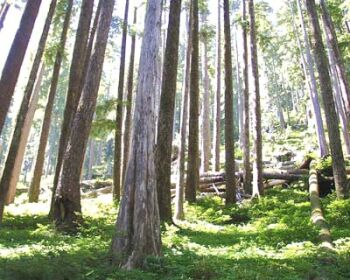
Publisher:
Bonnie King
CONTACT:
Newsroom@Salem-news.com
Advertising:
Adsales@Salem-news.com

~Truth~
~Justice~
~Peace~
TJP
Apr-21-2006 11:21

 TweetFollow @OregonNews
TweetFollow @OregonNews
Independent Study Finds Forestry Successfully Implementing Forest Plans
Salem-News.com
 Photo Courtesy: nps.gov |
(SALEM) - A recent independent study found that the Oregon Department of Forestry is successfully implementing its forest management plans for state forestland in northwest and southwest Oregon.
The study was conducted by Strategic Resource Systems, a nationally recognized firm from St. Johns, Michigan. The report will be presented April 27th to the Oregon Board of Forestry, which approved these management plans in 2001 for about 634,000 acres of state forestlands.
Among the findings, the study found that by using structure-based management, ODF is moving the primarily "middle-aged" forests toward a mixture of habitats, including complex forest stands which are similar to old-growth.
Structure-based management uses harvesting techniques variations of thinnings and clearcuts to develop diverse habitat for native wildlife species.
Thinnings promote tree growth and understory development, and clearcuts create patchy openings mimicking natural disturbances such as fire, disease and insect infestations, while still ensuring adequate timber harvest.
Completed in March, the assessment was seen as a way to give the Board of Forestry an overall picture after five years of forest management under the current plans. The ssessment reviewed implementation of the forest management plans, ranging from staff understanding of the plans to actual on-the-ground evaluations in the field to see if objectives were being met.
The report is posted on the ODF Web site at: http://oregon.gov/ODF/STATE_FORESTS/docs/Second_Party_Assessment_3-06_FINAL_REPORT.pdf
A primary goal of the NW and SW management plans for state-owned forestland is to achieve the "greatest permanent value" for the citizens of Oregon by providing a full range of social, economic and ecological benefits.
"We conducted the assessment to evaluate implementation and effectiveness of the plans to meet the greatest permanent value and the plan strategies," said Lisa DeBruyckere, director of the State Forests Program. "To this end, we contracted an assessment of the goals, objectives and procedures described in the plans to aid in measuring our performance against the full intent and standards presented in them."
The program plans to use the assessment to identify gaps in information. The assessment provides a base line from which future independent assessments will be made.
The study did cite some shortcomings. In the area of recreation, according to the study, some off-highway vehicle use near streams is causing erosion and sedimentation problems. It suggested that ODF seek "more cooperation with recreational users to construct and maintain facilities and control problematic users."
The study said the access system to the forests is good and being improved, but a few roads still need major upgrades. Some roads and stream crossings are introducing sediment to streams, and the study warned that wet-weather log hauling can harm even good roads.
It suggested that ODF consider a means for funding road improvements at an accelerated rate, other than relying solely on timber-sale revenues. One-third of the revenue from timber harvest is dedicated to manage the forests; two-thirds of the revenue is transmitted to counties and schools where the harvesting occurs.
The study noted that by following its forest management plans, ODF is doing a good job of protecting and diversifying fish and wildlife habitats. It said the habitat needs of northern spotted owls and marbled murrelets � two threatened species under the federal and state endangered species acts � are being addressed through surveys, habitat management and protection, and by restricting activities.
In terms of timber, the study said the harvest levels appear to be sustainable. It did offer some suggestions for improving timber production.
Wildlife browsing on regeneration stands (replanted after clearcuts) should be more formally monitored, the report said, and more complete slash burning could reduce habitats for over-abundant rodents. It also suggested lower-density plantings that could reduce the need for precommercial (a non-timber sale activity) thinnings.
The study said better stand-level record-keeping would help to determine the effectiveness of past treatments, such as thinnings. It said additional marketing opportunities might exist for both smaller and large diameter wood.
"Stable and sustainable timber harvest levels and other management programs appear to be providing a mix of values and outputs desired by the citizens of the state," the report stated. It also said that in addition to seeking objective information through a public opinion survey, ODF could provide more opportunities for regular, direct and local interaction with the public.
Articles for April 20, 2006 | Articles for April 21, 2006 | Articles for April 22, 2006

Salem-News.com:




Terms of Service | Privacy Policy
Comments are Closed on this story.
[Return to Top]
©2025 Salem-News.com. All opinions expressed in this article are those of the author and do not necessarily reflect those of Salem-News.com.